1
Based on its formal attributes and what you
learned in the course about the stylistic
developments of ancient Greek art, when was
the vessel below produced?
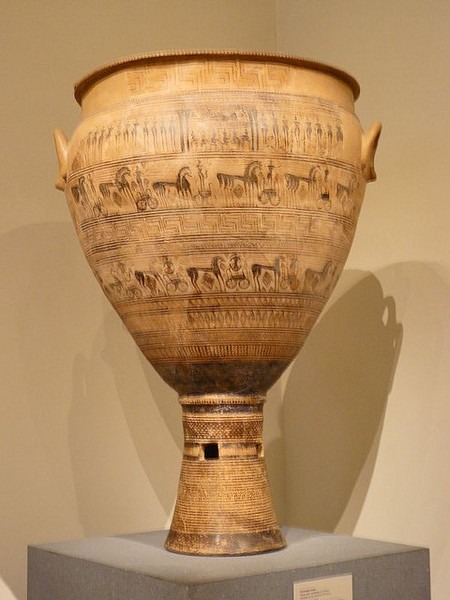
Choose one answer.
|
a.
During the 8th century B.C.
|
||
|
b.
During the 7th century B.C.
|
||
|
c.
During the 6th century B.C.
|
||
|
d.
During the 5th century B.C.
|
||
|
e.
During the 4th century B.C.
|
Question 2
The image below shows remains of pediment
sculptures from the temple of Zeus at
Olympia. Who is the central figure?
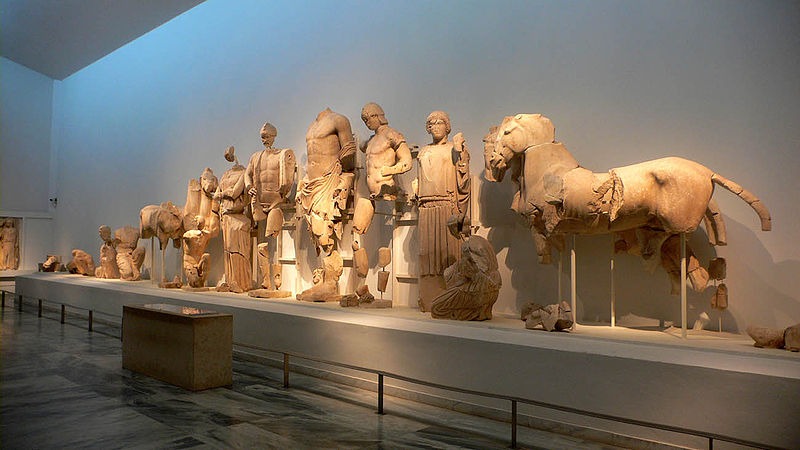
Choose one answer.
|
a.
The king of all the Olympian
gods |
||
|
b.
The deity who controls the sky
|
||
|
c.
The deity who controls the sea
|
||
|
d.
Both A and B |
||
|
e.
Both B and C |
Question 3
What is of special significance in Greek
art of the 7th century B.C.?
Choose one answer.
|
a.
Artistic conventions started
breaking away from Near Eastern
and Egyptian influence.
|
||
|
b.
A more naturalistic style
started emerging. |
||
|
c.
Animal hunts and composite
beasts were some of the
preferred subjects of pottery
painting. |
||
|
d.
Both A and B |
||
|
e.
Both B and C |
Question 4
Which Greek architectural order displays a
simple capital on the top of its columns
and a frieze divided into triglyphs and
metopes?
Choose one answer.
|
a.
The Ionic order |
||
|
b.
The Corinthian order
|
||
|
c.
The Doric order |
||
|
d.
The Composite order
|
||
|
e.
The Tuscan order |
Question 5
Which of the following best describes the
artistic achievements of the archaic period
in Greece?
Choose one answer.
|
a.
Monumental sculpture emerged.
|
||
|
b.
Architectural styles were
established in temple
architecture. |
||
|
c.
The Corinthian order replaced
the Doric order as a preferred
style of architecture.
|
||
|
d.
Both A and B |
||
|
e.
Both A and C |
Question 6
Which of the following best describes the
Geometric period of Greece?
Choose one answer.
|
a.
As trade with other
Mediterranean locations
increased and city-states
developed, artistic activity
was revived in the form of
painted pottery and bronze
statuettes. |
||
|
b.
The Geometric period witnessed
the development of writing and
Homer's epic poems.
|
||
|
c.
During the Geometric period in
Greece, colonies were
established. |
||
|
d.
All of the above |
||
|
e.
None of the above |
Question 7
Which of the following describes a
difference between a "Kouros" and a
"Korai"?
Choose one answer.
|
a.
The Kouros is always a male
figure, while the Korai is
always a female figure.
|
||
|
b.
The Kouros is always nude,
while the Korai is always
clothed. |
||
|
c.
The Kouros is always the
representation of a God, while
the Korai is always the
representation of a mortal.
|
||
|
d.
Both A and B |
||
|
e.
Both B and C |
Question 8
Which of the following statements
accurately characterizes the period
surrounding the "Dark Age" of Greece?
Choose one answer.
|
a.
The beginning of the "Dark Age"
of prehistoric Greece coincides
with the waning of the
Mycenaean civilization.
|
||
|
b.
Following the "Dark Age" of
Greece, city-states started to
emerge in the Peloponnese and
in Attica. |
||
|
c.
Following the "Dark Age" of
Greece, the Mycenaean
civilization emerged stronger
than it had been previously.
|
||
|
d.
Both A and B |
||
|
e.
Both B and C |
Question 9
Which of the following statements
accurately characterizes Geometric art?
Choose one answer.
|
a.
Geometric artifacts can take
the form of bronze votive
offerings. |
||
|
b.
Large-scale stone sculpture was
developed. |
||
|
c.
Geometric painting tends to
emphasize the roundness of the
human body. |
||
|
d.
Both A and B |
||
|
e.
Both B and C |
Question 10
Which of the following statements best
describes black and red-figure techniques
of ancient Greek vase painting?
Choose one answer.
|
a.
Red-figure techniques were used
as early as the geometric
period while black-figure
techniques only started to be
used in the archaic period.
|
||
|
b.
In the black-figure technique,
the background of the
represented scene is left the
color of the clay, while the
figures are applied with a slip
that turns black during firing.
|
||
|
c.
In the black-figure technique,
details of the figures are
applied with a slip.
|
||
|
d.
In the red-figure technique,
details of the figures are
achieved through incision.
|
||
|
e.
All of the above |
Question 11
Which of the following statements best
describes Orientalizing pottery?
Choose one answer.
|
a.
Orientalizing pottery painting
tended to show less detail in
the representation of human and
animal figures than Geometric
pottery painting did.
|
||
|
b.
Orientalizing pottery showed
the increased eastern influence
in the 7th century B.C.
|
||
|
c.
Orientalizing pottery painting
displayed many floral motifs
such as lotuses, palmettes, or
rosettes. |
||
|
d.
Both A and B |
||
|
e.
Both B and C |
Question 12
Which of the following statements best
describes the Hellenistic age?
Choose one answer.
|
a.
Under Alexander the Great,
Greek independent city-states
thrived. |
||
|
b.
Alexander the Great's rule
inaugurated an era of peace and
unification in the
Mediterranean basin.
|
||
|
c.
The spread of Hellenism under
Alexander resulted in a hybrid
and cosmopolitan culture.
|
||
|
d.
Both A and B |
||
|
e.
Both B and C |
Question 13
Which of the following statements best
describes the "Kouros"?
Choose one answer.
|
a.
The Kouros is a type of
monumental sculpture produced
during the archaic period of
ancient Greece. |
||
|
b.
The stylistic elements of the
Kouros are in large part
inherited from Egyptian
statuary. |
||
|
c.
The Kouros is a representation
of an ideal male figure in a
contrapposto position.
|
||
|
d.
Both A and B |
||
|
e.
Both B and C |
Question 14
Which of the following statements correctly
describes the vase below?
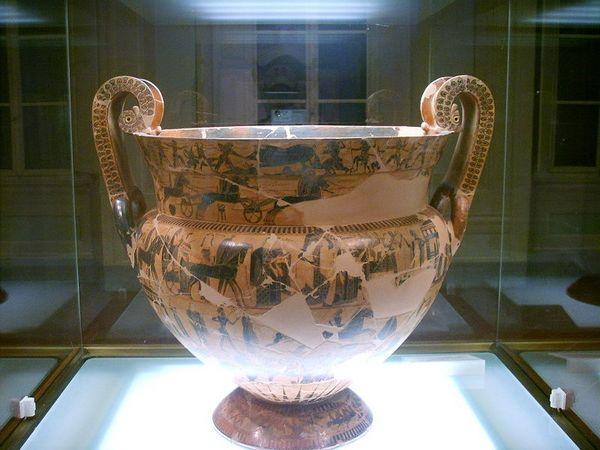
Choose one answer.
|
a.
It is commonly referred to as
the "Euphronios Calyx-Krater."
|
||
|
b.
It displays an increasing
interest for narration.
|
||
|
c.
The details of its represented
figures were applied with slip.
|
||
|
d.
Based on its monochromatic
quality, it can be recognized
as a Corinthian vessel.
|
||
|
e.
Based on the color of the
background, it can be
recognized as a Corinthian
vessel. |
Question 15
Which of the following statements correctly
represents ancient Greek temple decoration?
Choose one answer.
|
a.
Temples and their sculptures
were decorated in brightly
colored paints. |
||
|
b.
Ancient Greek temples and their
sculptures were often decorated
with gold and silver objects.
|
||
|
c.
Sculptures could fill friezes
and pediments. |
||
|
d.
All of the above |
||
|
e.
None of the above |
Question 16
Which of the following statements DOES NOT
accurately describe classical Athens?
Choose one answer.
|
a.
Classical Athens can be seen as
the birthplace of democracy.
|
||
|
b.
Greece's failure to help defeat
the Persians during the Persian
wars put democracy on hold.
|
||
|
c.
Athens became the head of the
Delian League in a defensive
effort against the Persians.
|
||
|
d.
The Peloponnesian war put an
end to Athens' classical age.
|
||
|
e.
None of the above |
Question 17
Which of the following statements DOES NOT
accurately describe the Greek temple?
Choose one answer.
|
a.
Greek temples were often built
on high ground. |
||
|
b.
A Greek temple usually stood on
its own, at a large distance
from any other building.
|
||
|
c.
Greek temples were oblong in
shape and had a peristyle
running around them.
|
||
|
d.
Both A and B |
||
|
e.
Both B and C |
Question 18
Which of the following statements DOES NOT
correctly associate a vessel type with its
intended function?
Choose one answer.
|
a.
Amphoras were used to mix wine
with water. |
||
|
b.
Kraters can often be linked to
funerary traditions.
|
||
|
c.
The panathanaic prize amphora
contained oil for the victors
of the Panathenaic games.
|
||
|
d.
The Oinochoe was a pouring
vessel. |
||
|
e.
Painted plates were often
suspended and displayed.
|
Question 19
Who was the sculpture made by Phidias for
the "cella" of the Parthenon a
representation of?
Choose one answer.
|
a.
A deity of war |
||
|
b.
Zeus's daughter |
||
|
c.
A personification of wisdom and
ingenuity |
||
|
d.
The patron goddess of Athens
|
||
|
e.
All of the above |
Question 20
Which of the following statements
accurately characterizes "Classical
Antiquity?"
Choose one answer.
|
a.
Classical Antiquity generally
refers to ancient Greece and
Rome. |
||
|
b.
Ancient Romans adopted many
ancient Greek traditions.
|
||
|
c.
Ancient Romans frequently made
marble copies of Greek
sculptures. |
||
|
d.
Classical Antiquity proved to
be foundational to Western art
and culture. |
||
|
e.
All of the above |
Question 21
What elements of 4th century B.C. Greek
sculpture were introduced by Praxiteles?
Choose one answer.
|
a.
The female nude |
||
|
b.
Slender proportions
|
||
|
c.
"Contrapposto" |
||
|
d.
Both A and B |
||
|
e.
Both B and C |
Question 22
What is the name of the temple below?
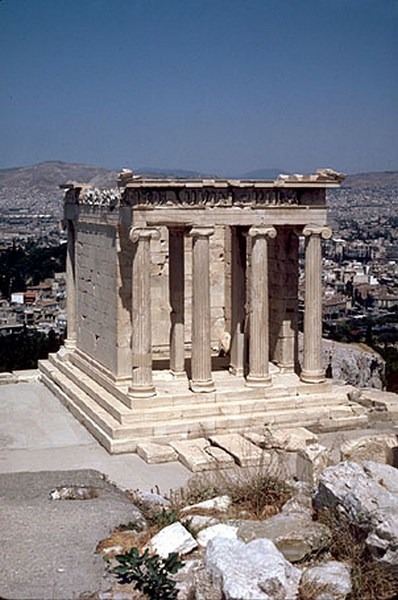
Choose one answer.
|
a.
The Temple of Zeus |
||
|
b.
The Erechtheum |
||
|
c.
The Temple of Athena Nike
|
||
|
d.
The Parthenon |
||
|
e.
The Propylaia |
Question 23
What was the colossal statue of Athena
inside the Parthenon made of?
Choose one answer.
|
a.
Bronze |
||
|
b.
Ivory |
||
|
c.
Gold |
||
|
d.
Both A and B |
||
|
e.
Both B and C |
Question 24
What were Athens and other Greek
city-states occupied with in the first half
of the 5th century B.C.?
Choose one answer.
|
a.
Maintaining its grip over the
Aegean |
||
|
b.
Organizing the defensive Delian
League |
||
|
c.
Entering into war with Persia
|
||
|
d.
All of the above |
||
|
e.
None of the above |
Question 25
Where and how did the architects of the
Parthenon use optical "refinements?"
Choose one answer.
|
a.
The columns of the peristyle
tilted outwardly. |
||
|
b.
The column shafts swelled.
|
||
|
c.
The floor of the temple was
curved convexly. |
||
|
d.
All of the above |
||
|
e.
None of the above |
Question 26
Which of the following DOES NOT constitute
one of the ways in which the Parthenon
expressed and asserted Athens' dominance
over the Aegean?
Choose one answer.
|
a.
The statue of Athena Parthenos
was probably nearly 40 feet
tall. |
||
|
b.
Its large pediments presented
larger-than-life sculpted
figures expressing Athena's
power. |
||
|
c.
It was larger than any previous
temple on the Greek mainland
had been. |
||
|
d.
It was built completely out of
marble. |
||
|
e.
All of the above |
Question 27
Which of the following statements
accurately characterizes the "Charioteer of
Delphi?"
Choose one answer.
|
a.
It is a marble sculpture.
|
||
|
b.
The represented figure
exuberantly communicates
emotion tied to his victory.
|
||
|
c.
It was created in the style of
Phidias. |
||
|
d.
His hair and beard are
represented in a very schematic
fashion. |
||
|
e.
None of the above |
Question 28
Which of the following statements
accurately describes the Parthenon and its
design?
Choose one answer.
|
a.
The temple design combines the
Doric and Ionic styles.
|
||
|
b.
The temple is made of marble.
|
||
|
c.
In the "cella", visitors could
walk all around the statue of
Athena. |
||
|
d.
The temple had more columns in
its colonnade than previous
temples. |
||
|
e.
All of the above |
Question 29
Which of the following statements
accurately describes the sculptural program
of the Parthenon?
Choose one answer.
|
a.
It was created under the
direction of the sculptor
Phidias. |
||
|
b.
The frieze and pediments were
decorated with gold statues.
|
||
|
c.
The pediment sculptures
depicted the Panathenaic
processions. |
||
|
d.
The metope reliefs recounted
the story of the struggle of
Athena against Poseidon over
Athens. |
||
|
e.
The sculptures on the pediments
are examples of relief
sculptures. |
Question 30
Which of the following statements
adequately characterizes Greek red-figure
pottery painting?
Choose one answer.
|
a.
Euphronios was one of the first
painters to use this technique.
|
||
|
b.
With the red-figure technique,
painters always incised details
such as facial features.
|
||
|
c.
With the red-figure technique,
it is harder to represent
anatomy than with the
black-figure technique.
|
||
|
d.
Both A and B |
||
|
e.
Both B and C |
Question 31
Which of the following statements best
describes the difference between Classical
Greek sculpture of the 5th century B.C. and
classical Greek sculpture of the 4th
century B.C.?
Choose one answer.
|
a.
Generally speaking, there began
to be less emphasis on
individual features.
|
||
|
b.
Generally speaking, there began
to be more of an interest in
the sensual rendering of the
female nude. |
||
|
c.
Generally speaking, there began
to be less emphasis on the
rendering of emotion.
|
||
|
d.
Both A and B |
||
|
e.
Both B and C |
Question 32
Which of the following statements correctly
describes a change of emphasis from archaic
Greek to classical Greek sculpture?
Choose one answer.
|
a.
During the classical period,
the human figure began to be
represented more realistically.
|
||
|
b.
During the classical period,
artists began to apply
principles of complementarity
in the representation of the
human body by rendering
contrasts between rigid,
working limbs and relaxed, at
rest limbs. |
||
|
c.
The "sever style" can be seen
as an early stage in the
development of classical
sculpture. |
||
|
d.
The new style of carving
exemplified by Phidias was made
possible by using clay models.
|
||
|
e.
All of the above |
Question 33
Which of the following statements is a
mischaracterization of the philosopher
Aristotle?
Choose one answer.
|
a.
He lived and worked in the 4th
century B.C. |
||
|
b.
He was a pupil of Plato.
|
||
|
c.
His pioneering work and thought
profited from a corpus of
knowledge made accessible
through Alexander's conquests.
|
||
|
d.
He was a pioneer in embryology,
biology, and physiology.
|
||
|
e.
He is most famous for his
thoughts on metaphysics and the
"world of essences."
|
Question 34
Which of the following statements is false
in regard to bronze and the techniques used
to make statuary with it?
Choose one answer.
|
a.
Ancient Greeks realized that
bronze had greater tensile
strength than copper.
|
||
|
b.
The technique of "sphyrelaton"
was the preferred technique
during the classical period of
Greek art. |
||
|
c.
The lost-wax technique became
the preferred technique of
producing bronze statuary
during the classical period of
Greek art. |
||
|
d.
The lost-wax technique is a
casting technique in which
bronze replaces molten wax.
|
||
|
e.
"Sphyrelaton" is a method that
involves hammering sheets of
metal. |
Question 35
Which of the following statements is true
about the Erechtheum?
Choose one answer.
|
a.
It is part of the complex on
the Acropolis of Athens.
|
||
|
b.
The Panathenic Procession ended
in one of its "cellas."
|
||
|
c.
The Porch of the Caryatids
features reclining nudes.
|
||
|
d.
Both A and B |
||
|
e.
Both B and C |
Question 36
Which of the following statements is true
of the art of Classical Greece?
Choose one answer.
|
a.
The Parthenon is an example of
Classical Greek architecture.
|
||
|
b.
The red-figure technique of
vase painting was developed
during the era of classical
Greek art. |
||
|
c.
Bronze became the preferred
medium for freestanding
sculptures. |
||
|
d.
All of the above |
||
|
e.
None of the above |
Question 37
Which of the following statements
misrepresents Greek sculpture of the 5th
century B.C.?
Choose one answer.
|
a.
Freestanding statuary was
frequently made of bronze.
|
||
|
b.
There was usually a stong
emphasis on individual features
in freestanding statuary.
|
||
|
c.
Sculptors, such as Phidias,
suggested a new kind of
vitality through the
representation of the human
figure. |
||
|
d.
Many sculptures expressed ideal
proportions and harmony.
|
||
|
e.
None of the above |
Question 38
Who came out victorious from the
Peloponnesian war at the beginning of the
4th century B.C.?
Choose one answer.
|
a.
Athens |
||
|
b.
Messene |
||
|
c.
Sparta |
||
|
d.
Corinth |
||
|
e.
Knossos |
Question 39
Who was Perikles?
Choose one answer.
|
a.
A statesman who launched a
building program for the
Acropolis of Athens
|
||
|
b.
The Architect of the Parthenon
|
||
|
c.
The sculptor who created the
statue of Athena for the
Parthenon |
||
|
d.
A philosopher |
||
|
e.
None of the above |
Question 40
Who was the Berlin painter?
Choose one answer.
|
a.
A pottery painter who abandoned
the use of superposed registers
so that the vases themselves
framed his figures |
||
|
b.
A black-figure vase painter
|
||
|
c.
A vase painter who worked in
the 6th century B.C.
|
||
|
d.
Both A and B |
||
|
e.
Both B and C |
Question 41
The end of which of the following wars
inaugurated the era of 5th century
classical art in Greece?
Choose one answer.
|
a.
The Trojan War |
||
|
b.
The Peloponnesian War
|
||
|
c.
The Persian Wars |
||
|
d.
The Punic Wars |
||
|
e.
None of the above |
Question 42
According to Rachel Mairs, which of the
following statements is accurate?
Choose one answer.
|
a.
At Ai Khanoum, there was
flexibility in religious
practice in Hellenistic times.
|
||
|
b.
Some artifacts from the Temple
of the Indented Niches at Ai
Khanoum display recognizably
Persian traits. |
||
|
c.
A contemporary local observer
might not have recognized an
indented niche as a
Mesopotamian trait.
|
||
|
d.
Asserting Greek identity in Ai
Khanoum was only important in
certain contexts. |
||
|
e.
All of the above |
Question 43
According to Rex Martienssen, which of the
following statements correctly describes
Hellenistic architecture and urbanism as
they are exemplified in Delos?
Choose one answer.
|
a.
The example of Delos shows how
Hellenistic houses conformed to
a standard arrangement.
|
||
|
b.
The Hellenistic city broke with
the geometry that had been
experimented with during
previous centuries.
|
||
|
c.
The contrast in between complex
civic architectural programs
and modest domestic
architectural programs reflects
the fact that Ancient Greeks'
world revolved around public
life. |
||
|
d.
Both A and B |
||
|
e.
Both B and C |
Question 44
According to Rex Martienssen, which of the
following aspects of the Hellenistic Greek
lifestyle is reflected in its domestic
architecture?
Choose one answer.
|
a.
Contact with the open air was
important. |
||
|
b.
The preparation of a meal and
its serving and enjoyment were
not to be experienced as
separate. |
||
|
c.
Though there was a focus on
privacy, it was relaxed as
compared with previous eras.
|
||
|
d.
All of the above |
||
|
e.
None of the above |
Question 45
How was the art of jewelry affected by the
social-historical context of the
Hellenistic era?
Choose one answer.
|
a.
Economic prosperity resulted in
a bigger demand for luxurious
gold jewelry. |
||
|
b.
The desire for ostentation
resulted in the creation of
very intricately and complexly
designed jewelry. |
||
|
c.
A lot of gold was circulated
due to Alexander having seized
Babylonian objects.
|
||
|
d.
In the Persian fashion,
bracelets were frequently worn
in pairs. |
||
|
e.
All of the above |
Question 46
What were the effects of Hellenistic
imperialism on the art of Cyprus?
Choose one answer.
|
a.
Portraiture, used in the
representation of members of
royalty, became the most
prominent type of stone
sculpture. |
||
|
b.
Stylistically, there was as
strong Egyptian influence.
|
||
|
c.
The rule of the Ptolemies was
expressed through great
uniformity in artistic style,
with the Alexandrian style as
its model. |
||
|
d.
Both A and B |
||
|
e.
Both B and C |
Question 47
Which of the following best describes the
Hellenistic "Soldiers' Tomb" of Alexandria?
Choose one answer.
|
a.
It was built to commemorate
foreign mercenaries who fought
for the Ptolemaic kingdom.
|
||
|
b.
It mostly displays
representations of gods.
|
||
|
c.
It reverts back to more
"archaic" techniques of
painting. |
||
|
d.
It displays a restricted
palette due to the use of
strictly local pigments.
|
||
|
e.
None of the above |
Question 48
Which of the following is a Hellenistic
innovation in the domain of pottery?
Choose one answer.
|
a.
The red-figure technique
|
||
|
b.
The white-ground technique
|
||
|
c.
Mould-made relief |
||
|
d.
Both A and B |
||
|
e.
Both A and C |
Question 49
Which of the following is false in regard
to Hellenistic mosaics?
Choose one answer.
|
a.
Starting in the second century
B.C., mosaics were a widespread
medium in the interior
decoration of wealthy homes in
every part of the Hellenistic
empire. |
||
|
b.
The increase in mosaic
production can be seen as a
result of economic prosperity.
|
||
|
c.
The increase in mosaic
production can be seen as a
result of the desire to live
lavishly and fashionably.
|
||
|
d.
Starting in the second century
B.C., tessellated mosaics
became an exclusive medium of
interior decoration used only
in royal palaces. |
||
|
e.
All of the above |
Question 50
Which of the following is false in regard
to the "Temple with indented Niches" at Ai
Khanoum?
Choose one answer.
|
a.
It had a typical Greek plan.
|
||
|
b.
It had a cult statue in its
"cella." |
||
|
c.
Its niched decorations recall
the art of Mesopotamia.
|
||
|
d.
Both A and B |
||
|
e.
Both B and C |
Question 51
Which of the following is false in regard
to trends in Hellenistic pottery?
Choose one answer.
|
a.
Hellenistic pottery seems to
have sometimes emulated other
media, such as metal vessels,
"gold glass" bowls, or the
sculpture and architecture of
the period. |
||
|
b.
Generally speaking, the colors
of polychrome pottery were
usually more subdued than those
of the older red-figure style.
|
||
|
c.
Often, the new trends and
techniques developed during the
Hellenistic era can be said to
have stemmed from the desire to
imitate the opulent objects
that were being created to
decorate royal palaces.
|
||
|
d.
All of the above |
||
|
e.
None of the above |
Question 52
Which of the following statements
accurately describes trends in Hellenistic
sculpture?
Choose one answer.
|
a.
With the construction of
palaces and very ambitious
architectural programs,
sculptural decoration was
important. |
||
|
b.
Many copies of Classical Greek
masterworks were made during
the Hellenistic period.
|
||
|
c.
There was an interest in
representing historical
figures, such as philosophers
of the past. |
||
|
d.
All of the above |
||
|
e.
None of the above |
Question 53
Which of the following statements best
describes Athens' architecture and planning
during the Hellenistic age?
Choose one answer.
|
a.
Athens adopted new Hellenistic
trends while retaining its core
and self. |
||
|
b.
Modernization of buildings in
the Agora reflected the
Hellenistic interest for
functionality. |
||
|
c.
The arch started to be used in
a more obvious and symbolic
way. |
||
|
d.
All of the above |
||
|
e.
None of the above |
Question 54
Which of the following statements best
describes the shift from Classical to
Hellenistic as it applies to sculpture?
Choose one answer.
|
a.
There was a shift from harmony
and balance to "pathos" and
emotion. |
||
|
b.
There was a shift toward more
secularism in the
representation of Greek gods.
|
||
|
c.
There was a shift toward a more
restricted range of
subject-matter. |
||
|
d.
Both A and B |
||
|
e.
Both B and C |
Question 55
Which of the following statements best
describes the Hellenistic interior
treatment of houses in Delos according to
Rex Martienssen?
Choose one answer.
|
a.
Wall decoration was formally
organized according to
structural elements of
architecture. |
||
|
b.
Interior walls displayed bright
colors. |
||
|
c.
Within one room, only analogous
colors were used. |
||
|
d.
Both A and B |
||
|
e.
Both B and C |
Question 56
Which of the following statements describes
an aspect of Hellenistic art?
Choose one answer.
|
a.
The everyday and ordinary
became worthy of being
represented in art.
|
||
|
b.
Individuality became a more
prominent feature of figural
representations. |
||
|
c.
Overall, Hellenistic art seems
to remain fairly static.
|
||
|
d.
Both A and B |
||
|
e.
Both B and C |
Question 57
Which of the following statements describes
the way Hellenistic mosaics functioned
within homes?
Choose one answer.
|
a.
Though many mosaic-related
innovations took place in the
Hellenistic period, it seems as
though mosaics became less
numerous within houses than
they had been during the
classical era. |
||
|
b.
Unlike classical mosaics,
Hellenistic mosaics were mostly
enjoyed privately, in spaces
usually only used by their
owner. |
||
|
c.
The materials used and the
complexity of design implied
either the mosaics' lesser or
greater significance.
|
||
|
d.
Both A and B |
||
|
e.
Both B and C |
Question 58
Which of the following statements DOES NOT
accurately describe the "Maison de la
Colline" in Delos?
Choose one answer.
|
a.
Like most Hellenistic houses,
it has only one floor.
|
||
|
b.
The main rooms can be entered
from a portico that spans the
whole width of the house.
|
||
|
c.
Most of the rooms had windows
that faced the street.
|
||
|
d.
Both A and B |
||
|
e.
All of the above |
Question 59
Which of the following statements
mischaracterizes Hellenistic Ai Khanoum?
Choose one answer.
|
a.
Its Hellenistic name is
"Alexandria on Oxus."
|
||
|
b.
It was founded over a
previously Persian city and is
located in present-day
Afghanistan. |
||
|
c.
It was central to the empire.
|
||
|
d.
Both A and B |
||
|
e.
Both B and C |
Question 60
Which of the following statements, on the
topic of Greek sculpture, is true?
Choose one answer.
|
a.
While Hellenistic female
figures of deities were much
inspired by those of the
classical era, they seem to
draw less focus on the
sensuality of their bodies than
those of the classical era do.
|
||
|
b.
While Hellenistic male figures
were much inspired by those of
the classical era, their faces
and unbridled hair express more
intensity. |
||
|
c.
In Hellenistic sculpture, large
narrative groups are usually
set in a frieze. |
||
|
d.
Both A and B |
||
|
e.
Both A and C |
Question 61
Which of the following is false in regard
to the Hellenistic period of Greece?
Choose one answer.
|
a.
The Hellenistic period was a
time of turmoil in Greece, when
many traditional structures,
such as the city-state, were
shaken. |
||
|
b.
In Greece, there developed a
trend, most famously with
Epicureanism, to avoid politics
and active participation in
public life and to conquer fear
of gods. |
||
|
c.
Alexander the Great established
well-structured and stable
administrations in the regions
he conquered. |
||
|
d.
Alexandria became a great
center of research, science,
and commerce. |
||
|
e.
All of the above. |
Question 62
According to Francesca Tronchin, which of
the following is an important aspect of
Roman art?
Choose one answer.
|
a.
Its exclusively Greek-inspired
style |
||
|
b.
Its focus on the depiction of
specific individuals
|
||
|
c.
Its focus on the depiction of
specific historical events
|
||
|
d.
Both A and B |
||
|
e.
Both B and C |
Question 63
Individuals of which age and gender were
most prominently represented in Roman
Republican portraiture?
Choose one answer.
|
a.
Young men |
||
|
b.
Elderly men |
||
|
c.
Young women |
||
|
d.
Elderly women |
||
|
e.
Children of both genders
|
Question 64
The first style of Roman painting did which
of the following?
Choose one answer.
|
a.
Most significantly tried to
emulate marble |
||
|
b.
Often divided walls into three
parts |
||
|
c.
Was inspired by Hellenisitc
painting |
||
|
d.
All of the above |
||
|
e.
None of the above |
Question 65
The people of which city-states were
involved in the Punic Wars 3rd and 2nd
century B.C.?
Choose one answer.
|
a.
Athens and Rome |
||
|
b.
Carthage and Rome |
||
|
c.
Athens and Sparta |
||
|
d.
Rome and Vulci |
||
|
e.
Rome and Tarquinii |
Question 66
The second style of Roman painting did
which of the following?
Choose one answer.
|
a.
Emerged with the Roman
colonization of Pompeii
|
||
|
b.
Rendered architectural forms
|
||
|
c.
Lacked the use of shading or
perspective |
||
|
d.
Both A and B |
||
|
e.
Both B and C |
Question 67
What are some common characteristics of
Etruscan statuary?
Choose one answer.
|
a.
Etruscan sculpted figures often
display more implied motion
than Greek sculpted figures.
|
||
|
b.
Terracotta is one of its common
materials. |
||
|
c.
Figures are often depicted
smiling. |
||
|
d.
All of the above |
||
|
e.
None of the above |
Question 68
What are some of the Greek-inspired
elements of the Roman Republican Temple of
Portunus?
Choose one answer.
|
a.
Columns with Ionic capitals
|
||
|
b.
A raised podium |
||
|
c.
Stairs on only one side
|
||
|
d.
Free-standing columns all
around the temple |
||
|
e.
All of the above |
Question 69
Which approximate area of Italy did the
Etruscans dominate before they were
conquered by the Romans?
Choose one answer.
|
a.
Southern Italy |
||
|
b.
Central Italy |
||
|
c.
Eastern Coastal Italy
|
||
|
d.
Both A and B |
||
|
e.
Both B and C |
Question 70
Which of the following accurately
characterizes Etruscan temples?
Choose one answer.
|
a.
They had wooden columns.
|
||
|
b.
They usually had two chambers,
each one dedicated to one of
the two main Etruscan Gods.
|
||
|
c.
They had stairs on all sides.
|
||
|
d.
Both A and B |
||
|
e.
Both B and C |
Question 71
Which of the following accurately describes
an aspect of the social-political structure
that the Roman Republic brought?
Choose one answer.
|
a.
There were no slaves.
|
||
|
b.
The senate became a permanent
part of the government.
|
||
|
c.
Elected consuls replaced kings.
|
||
|
d.
Both A and B |
||
|
e.
Both B and C |
Question 72
Which of the following is false of Roman
portrait busts of the Republican period?
Choose one answer.
|
a.
They were often very realistic.
|
||
|
b.
They were often associated with
a funerary context.
|
||
|
c.
They mostly emphasized the
youth of the sitter.
|
||
|
d.
Both A and B |
||
|
e.
Both B and C |
Question 73
Which of the following statements
accurately describes the difference between
Etruscan and Greek archaic temples?
Choose one answer.
|
a.
Statuary decorated Etruscan
temple friezes and pediments,
while Greek temples displayed
statuary on their roofs.
|
||
|
b.
Unlike Greek temples, Etruscan
temples displayed marble
statuary. |
||
|
c.
Archaic Etruscan temples were
made of wood, mud and brick,
while archaic Greek temples
were made of marble.
|
||
|
d.
Unlike Etruscan temples, Greek
temples sat on a large podium.
|
||
|
e.
None of the above |
Question 74
Which of the following statements
accurately describes the "Porticus Aemilia"
in Rome?
Choose one answer.
|
a.
It was a warehouse in ancient
Rome. |
||
|
b.
Its vaulted interior allowed
lateral as well as axial
movement on the inside.
|
||
|
c.
Its construction was
facilitated by the use of
concrete. |
||
|
d.
It had barrel vaults.
|
||
|
e.
All of the above |
Question 75
Which of the following statements
accurately describes the art of portraiture
during the Roman Republic?
Choose one answer.
|
a.
Most portrait busts emphasized
the youth of the sitter.
|
||
|
b.
Idealization is usually
associated with the Republican
style of portraits.
|
||
|
c.
Portraits of the Roman Republic
were usually made for private
use. |
||
|
d.
All of the above |
||
|
e.
None of the above |
Question 76
Which of the following statements best
describes the "Altar of Domitius
Ahenobarbus?"
Choose one answer.
|
a.
It is a sculpted relief,
probably a statue base.
|
||
|
b.
It depicts exclusively
mythological scenes.
|
||
|
c.
The side depicting the wedding
of Neptune is less Greek in
style than the other side.
|
||
|
d.
The side depicting the wedding
of Neptune is carved in very
low relief. |
||
|
e.
None of the above |
Question 77
Which of the following statements correctly
describes Roman concrete?
Choose one answer.
|
a.
It began to be experimented
with in the 2nd century A.D.
|
||
|
b.
It is a composite of natural
elements mixed with wax.
|
||
|
c.
Its composition includes stone
rubble, lime, and sand.
|
||
|
d.
Concrete is cut and quarried.
|
||
|
e.
The use of concrete results in
exclusively rectilinear
architecture. |
Question 78
Which of the following statements DOES NOT
accurately describe Etruscan art?
Choose one answer.
|
a.
Though Etruscans were much
inspired by Greek art, they did
not use bronze as a sculptural
media. |
||
|
b.
Sarcophagi often featured a
reclining figure of the
deceased on its lid.
|
||
|
c.
Sarcophagi and tomb paintings
can show wives and husbands
together. |
||
|
d.
The Etruscans developed their
counterpart to the Greek
"Korai." |
||
|
e.
Etruscan art, like Greek art,
went through an orientalizing
period in the 7th century B.C.
|
Question 79
Who were the most powerful citizens during
the early Roman Republic?
Choose one answer.
|
a.
The Plebs |
||
|
b.
The Patricians |
||
|
c.
The Equites |
||
|
d.
The Slaves |
||
|
e.
None of the above |
Question 80
Whom is this a portrait of?
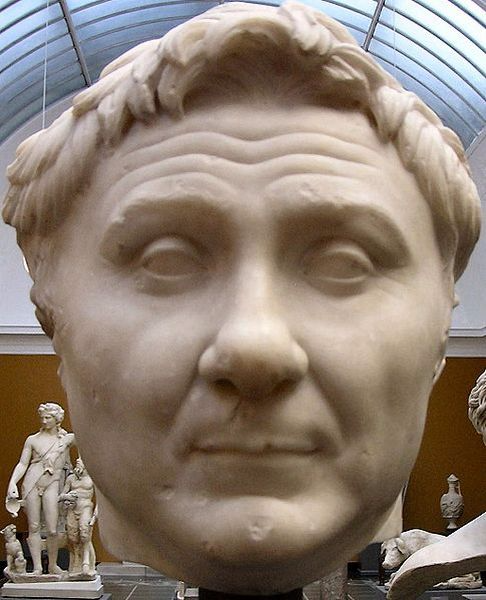
Choose one answer.
|
a.
Augustus |
||
|
b.
Julius Caesar |
||
|
c.
Plato |
||
|
d.
Alexander the Great
|
||
|
e.
Pompey the Great |
Question 81
Which of the following is false about the
ancient Etruscan people?
Choose one answer.
|
a.
They were admirers of Greek
painted vessels. |
||
|
b.
They had an alphabet adapted
from Greek letters.
|
||
|
c.
They achieved great engineering
feats. |
||
|
d.
Their alphabet served as a
basis for the Latin alphabet.
|
||
|
e.
None of the above |
Question 82
How did Augustus advertise his authority?
Choose one answer.
|
a.
As functioning within Rome's
framework of magistracies
|
||
|
b.
As a combination of
magistracies |
||
|
c.
As a dictatorship |
||
|
d.
Both A and B |
||
|
e.
Both B and C |
Question 83
In his "Ten Books of Architecture," how
does Vitruvius describe the symmetry of a
building?
Choose one answer.
|
a.
As what could be called "strict
bilateral symmetry"
|
||
|
b.
As what could be called a
"unified and balanced whole"
|
||
|
c.
As similar to the harmony of
the human body |
||
|
d.
Both A and B |
||
|
e.
Both B and C |
Question 84
In his "Ten Books of Architecture,"
Vitruvius does which of the following?
Choose one answer.
|
a.
Makes a dedication to Augustus
|
||
|
b.
Describes the good architect as
being learned, among other
things, in history, philosophy,
music, and astronomy
|
||
|
c.
Makes "order" an indispensable
attribute of good architecture
|
||
|
d.
Makes "economy" an
indispensable attribute of good
architecture |
||
|
e.
All of the above |
Question 85
What can be said of the houses at Bulla
Regia?
Choose one answer.
|
a.
Overall, they are not
symmetrical in the Roman style.
|
||
|
b.
Their sunken courts with
mosaics can be considered
African in style. |
||
|
c.
They were often used to display
status and Greek culture.
|
||
|
d.
Both A and B |
||
|
e.
Both B and C |
Question 86
What has fieldwork at Portus, the main port
of Rome in ancient times, uncovered?
Choose one answer.
|
a.
The Trajanic harbor was
hexagonal in shape.
|
||
|
b.
Luxurious temples were built on
the water front to impress
visitors. |
||
|
c.
The cisterns were made with
marble. |
||
|
d.
Both A and B |
||
|
e.
Both B and C |
Question 87
What is the monument below? How does it fit
into history and the history of art?
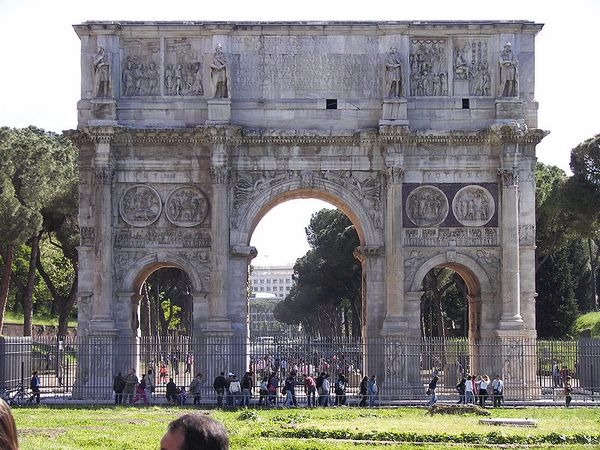
Choose one answer.
|
a.
This monument is a triumphal
arch dedicated to Constantine.
|
||
|
b.
In its relief depicting the
emperor distributing money,
there is a stylistic evolution
that can be considered
transitional in between Roman
and Medieval art. |
||
|
c.
Its reliefs of the emperor
distributing money can be seen
as signaling a 4th-century
shift in the way an emperor
represented himself in relation
to his subjects. |
||
|
d.
All of the above |
||
|
e.
None of the above |
Question 88
Which of the following best describes
technology and infrastructure used
throughout the Roman Empire?
Choose one answer.
|
a.
A network of roads was
constructed for warfare
purposes. |
||
|
b.
City streets featured
sidewalks. |
||
|
c.
Water power was used to make
flower. |
||
|
d.
Water was transported from hill
tops via aqueducts.
|
||
|
e.
All of the above |
Question 89
Which of the following best describes the
Colosseum?
Choose one answer.
|
a.
It is a Julio-Claudian
amphitheater. |
||
|
b.
It has three stories of arches
with Tuscan columns.
|
||
|
c.
It was made possible by the use
of molded concrete.
|
||
|
d.
All of the above |
||
|
e.
None of the above |
Question 90
Which of the following best describes The
Pantheon?
Choose one answer.
|
a.
It was conceived as a temple to
Venus Genitrix. |
||
|
b.
It used coffers to lighten its
dome. |
||
|
c.
Its walls are 20 feet thick
from top to bottom.
|
||
|
d.
Both A and B |
||
|
e.
Both B and C |
Question 91
Which of the following best summarizes why
the "Ara Pacis" reliefs are often used to
illustrate Roman style in the visual arts?
Choose one answer.
|
a.
They are on an important
monument made during a pivotal
moment in Roman history and
commissioned by the first Roman
Emperor. |
||
|
b.
They illustrate the importance
of ancestral lineage and how
this lineage can be tied to
mythological figures in Roman
culture. |
||
|
c.
They illustrate the way in
which Roman art absorbed
Classical Greek art.
|
||
|
d.
They illustrate the typical
Roman characteristic that is a
focus on actual events and
people. |
||
|
e.
All of the above |
Question 92
Which of the following can be said of
Augustus's building objectives?
Choose one answer.
|
a.
He wanted to transform Rome on
the model of Athens.
|
||
|
b.
At the time of his building
projects, marble was available.
|
||
|
c.
He wanted to transform Rome in
the way Perikles had
transformed Athens.
|
||
|
d.
All of the above |
||
|
e.
None of the above |
Question 93
Which of the following correctly describes
the free-standing sculpture below?

Choose one answer.
|
a.
It is a representation of the
emperor Trajan. |
||
|
b.
The represented figure holds a
spear, a symbol of imperial
power. |
||
|
c.
The pose of the figure is
reminiscent of a sixth century
B.C. Greek Kouros. |
||
|
d.
There are no traces of
individualization; the
representation is purely
archetypal. |
||
|
e.
This is a realistic depiction
of a specific emperor; it shows
what the emperor looked like at
the time when the statue was
made. |
Question 94
Which of the following DOES NOT accurately
describe Augustus's forum?
Choose one answer.
|
a.
In an effort to associate
himself with Julius Caesar,
Augustus had his forum built
right next to Caesar's.
|
||
|
b.
Its plan follows the plan of
Julius Caesar's forum.
|
||
|
c.
A temple to Jupiter was made
the focus of the forum and was
symbolic of Augustus' avenge of
Caesar. |
||
|
d.
He made specific references to
Greek reliefs and sculptures of
the Acropolis. |
||
|
e.
All of the above |
Question 95
Which of the following empires were
completely or partially absorbed by the
Roman Empire?
Choose one answer.
|
a.
The Greek Empire |
||
|
b.
The Carthaginian Empire
|
||
|
c.
The Hellenistic Empire
|
||
|
d.
All of the above |
||
|
e.
None of the above |
Question 96
Which of the following is an accurate
characterization of the monument
below?
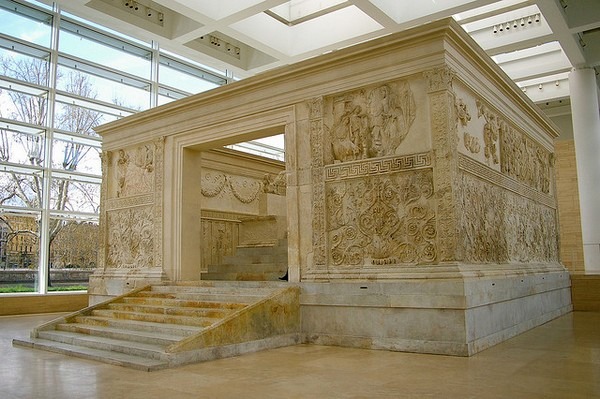
Choose one answer.
|
a.
It was built in honor of the
Emperor Trajan. |
||
|
b.
It was made of concrete.
|
||
|
c.
An altar was located in its
center. |
||
|
d.
It featured two staircases.
|
||
|
e.
Its relief sculpture depicts
exclusively depicts the
emperor's family. |
Question 97
Which of the following statements
adequately describes the city of Thugga?
Choose one answer.
|
a.
Before becoming a Roman
province, it was an urban
center of the kingdom of
Numibia. |
||
|
b.
Previous to Roman colonization,
Thugga had been exposed to
Hellenistic influence.
|
||
|
c.
The plans of its temples of
Saturn and Mercury are
typically Roman. |
||
|
d.
Both A and B |
||
|
e.
Both B and C |
Question 98
Which of the following statements DOES NOT
accurately describe the age of the "Five
Good Emperors?
Choose one answer.
|
a.
Ambitious building programs
were undertaken. |
||
|
b.
The gap between Romans and
provincials narrowed, and this
was reflected in sculpture.
|
||
|
c.
Augustus was the first of the
"Five Good Emperors."
|
||
|
d.
Both A and B |
||
|
e.
Both B and C |
Question 99
Which of the following statements DOES NOT
describe the monument below?
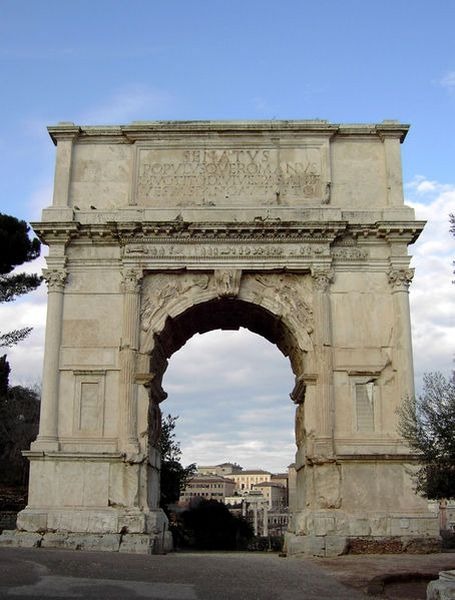
Choose one answer.
|
a.
It was built to commemorate
Titus and the sack of
Jerusalem. |
||
|
b.
One of its reliefs shows the
Roman army taking a menorah
from the temple of Jerusalem.
|
||
|
c.
Its relief sculptures are very
schematic in style.
|
||
|
d.
Both A and B |
||
|
e.
Both B and C |
Question 100
Which style did the Romans particularly
like to use in their capitals?
Choose one answer.
|
a.
Doric |
||
|
b.
Ionic |
||
|
c.
Corinthian |
||
|
d.
Tuscan |
||
|
e.
Composite |
Question 101
Which of the following statements
mischaracterizes the dome shown here?
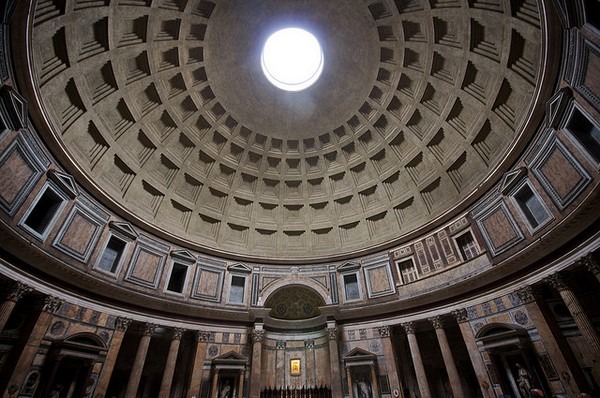
Choose one answer.
|
a.
It is the dome of the Pantheon.
|
||
|
b.
It is made of cut stone.
|
||
|
c.
It made use of a mold.
|
||
|
d.
All of the above |
||
|
e.
None of the above |